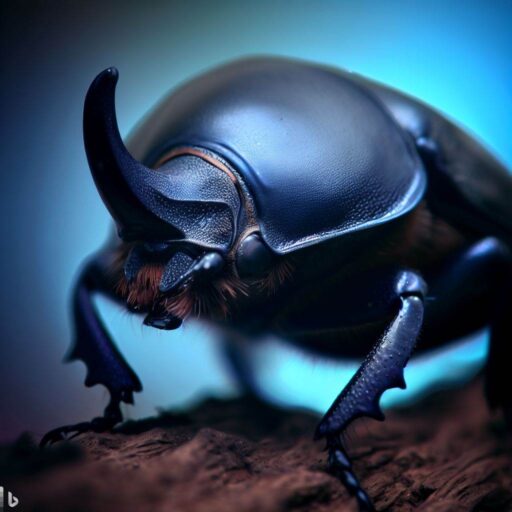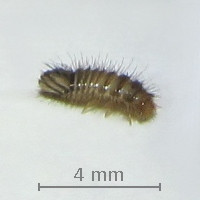Key takeaway:
- Carpet beetles come from various entry points, such as windows, doors, and cracks, and are attracted to sources of food like fibers and fabrics.
- Carpet beetle infestations can cause damage to fabrics and belongings, and can be identified by the presence of adult beetles and larvae.
- Prevention and control measures for carpet beetles include regular cleaning, decluttering, proper storage, vacuuming, washing, and the use of insecticides and repellents. If necessary, professional pest control services can be sought.
Carpet beetles can be a persistent and frustrating problem in many households.
In this section, we will dive into the world of carpet beetles, learning about their origins and why they tend to infiltrate our homes.
We will also explore the different species of carpet beetles and their distinctive characteristics, shedding light on their behavior and habits.
So, let’s uncover the secrets behind these tiny yet troublesome creatures.
What are Carpet Beetles?
Carpet beetles are pesky insects that can cause damage to fabrics and belongings. Also, known as “clothes munchers,” they come in different species.
They love natural fibers like wool, silk, and fur which they feed on and use for breeding. Identifying an infestation is easy, look out for adult beetles and their larvae.
They get into homes through cracks, windows, and doors. They search for food and favorable conditions to breed. The eggs of these bugs are usually near food sources like carpets, clothing, or upholstery.
Signs of an infestation include damage to fabrics and belongings due to feeding on the fibers. Adult beetles and their larvae are also present. They are small and oval-shaped with patterns on their wings.
Preventing infestations is key. Clean and declutter. Remove dust, lint, and other debris that could be food sources. Store fabrics and belongings in airtight containers or bags. Vacuum carpets regularly and wash clothing items before storage. Insecticides and repellents may be used in severe cases.
If the infestation is severe, contact a pest control service. Assured Environments is experienced in handling carpet beetle problems. They can assess the severity and provide tailored solutions. Contact them for prompt and efficient help if you suspect a carpet beetle infestation.
Carpet Beetle Species and Characteristics
Carpet beetles are a type of dreaded pest. They come in many species and have various traits that make them distinct from other beetles.
These bugs can enter your home from different sources and have specific behaviors when it comes to breeding and eating.
- Different carpet beetle species come in various colors, sizes, and patterns.
- They are small bugs with an oval shape and six legs.
- Their larvae can be mistaken for tiny worms or caterpillars as they’re covered in bristles.
- Some species of carpet beetles can fly, while others can’t.
- The lifespan of these beetles can range from several weeks to several months, depending on the species.
Not only do carpet beetles differ in species and physical features, but they also have unique behavior. For example, they’re attracted to natural fibers like wool, silk, and fur, making these materials more prone to infestation.
Additionally, they prefer dark and quiet places, like closets and storage areas.
To keep carpet beetle infestations out of your home, there are a few things you can do.
Regular cleaning and tidying up helps remove possible food sources for the beetles.
Properly storing fabrics and belongings in sealed bags or containers can also protect them from infestation.
Vacuuming carpets and washing fabrics regularly is another way to get rid of existing beetles or larvae.
Insecticides and repellents can be used if preventive measures fail. But be careful when using these products and follow the instructions to avoid any harm to humans or pets.
If the infestation is too much to handle, it’s best to call a professional. Assured Environments is one such provider that specializes in handling pest issues, including carpet beetle infestations.
By knowing the species and characteristics of carpet beetles, taking preventive measures, and getting help when needed, you can effectively control and manage these pests in your home.
Where Do Carpet Beetles Come From?
Carpet beetles, tiny but notorious household pests, can infiltrate our homes through various entry points. Understanding where these pests come from is crucial in preventing and combating infestations.
In this section, we will explore the infestation entry points that carpet beetles exploit, as well as delve into their breeding and feeding habits.
By shedding light on these aspects, we can equip ourselves with valuable knowledge to effectively protect our homes from carpet beetle infestations.
Infestation Entry Points
Carpet beetles are particularly cunning when infiltrating spaces, as even the tiniest of cracks and gaps can serve as gateways.
Sealing visible cracks, inspecting vents and ducts regularly, and being wary of second-hand items are all steps one can take to prevent infestation.
It is worth noting that even with proper preventive measures, infestations can still occur through hidden openings.
Such was the case in a well-maintained household where built-in cabinets had openings that were overlooked during inspections. Thus, it is essential to be thorough when identifying potential entry points.
These voracious critters feed exclusively on fabrics and personal belongings, making it all the more important to take the necessary steps to reduce the risk of infestation.
Breeding and Feeding Habits
Carpet beetles reproduce by laying eggs. These hatch into larvae that feed on natural fibers such as wool, silk, fur, feathers, and animal hides. They can also eat synthetic materials blended with natural fibers. Outdoors, larvae feed on pollen and nectar from flowers.
The carpet beetle’s life cycle is complete metamorphosis: eggs, larvae, pupae, and adults. The adults mainly feed on nectar and pollen, but may enter homes looking for somewhere to breed.
It’s important to note: carpet beetles don’t bite or sting humans. To prevent infestations, clean and declutter regularly. Store fabrics and belongings in sealed containers or bags. Vacuum carpets and wash fabrics to remove eggs and larvae.
Use insecticides and repellents designed for carpet beetle control. With these measures, you can reduce the risk of infestation. If you find mysterious holes in your sweater, you may have uninvited guests.
Signs of a Carpet Beetle Infestation
Carpet beetle infestations can wreak havoc on your fabrics and belongings, causing significant damage. In this section, we’ll explore the signs of a carpet beetle infestation, including the presence of adult beetles and larvae.
Understanding these indicators is crucial for early detection and effective pest control. Don’t let these tiny pests ruin your treasured possessions – read on to learn how to identify and address a carpet beetle infestation.
Damage to Fabrics and Belongings
Carpet beetles can cause major damage to fabrics and belongings. They eat various materials like wool, fur, feathers, and synthetic fibers. The larvae are the biggest threat as they have strong mouthparts to chew through these items.
Carpets, clothing, curtains, and upholstered furniture can show signs of damage such as irregular holes or gnawed edges.
Identifying a carpet beetle infestation is not hard. Adult beetles are small and come in different colors from black to brown or mottled patterns. Larvae can be different sizes and colors, often tan or brown with dark bands.
They may leave molted skins or fecal pellets resembling tiny grains of sand. There can also be a distinct odor from the beetles’ secretions.
Acting fast is key to stop more damage. Clean and declutter to reduce food sources. Store fabrics and belongings in sealed containers or bags. Vacuum and wash infested items in hot water.
Seeking professional help is essential for removal and prevention of carpet beetle infestations. Assured Environments, a professional pest control service provider, is the right choice.
Presence of Adult Beetles and Larvae
A Table reveals more info about adult beetles and larvae in a carpet beetle infestation:
| Characteristics | Adult Beetles | Larvae |
|---|---|---|
| Appearance | Oval-shaped | Small, cylindrical |
| Size | 1.7-3.5 mm | Varies with stage |
| Color | Black, brown, or combo colors | Varies according to species |
| Flight Ability | Yes | No |
Other signs of adult beetles and larvae include:
- Shed skins or casings left by larvae
- Damage to fabrics and belongings from feeding larvae.
To manage a carpet beetle infestation:
- Clean and declutter
- Store fabrics and belongings in sealed containers
- Vacuum carpets and furniture regularly
- Wash fabrics at high temperatures
- Use insecticides and repellents as part of an integrated pest management strategy.
If the infestation is too much, contact Assured Environments. Take action now to avoid adult beetles and larvae causing damage. Don’t wait, contact Assured Environments today.
Prevention and Control Measures
Prevention and control measures are vital when it comes to dealing with carpet beetles. From regular cleaning and decluttering to proper storage of fabrics and belongings, the right approach is crucial.
Vacuuming and washing also play a crucial role, as well as the judicious use of insecticides and repellents. By implementing these measures, you can effectively combat carpet beetle infestations and protect your home from these pesky intruders.
Regular Cleaning and Decluttering
Regular cleaning and decluttering are essential in controlling carpet beetle infestations. Doing this helps to remove potential food sources and breeding grounds.
To fight carpet beetles:
- Clear away any clutter that can be hiding places.
- Vacuum regularly, especially in areas like carpets, rugs, furniture, and curtains.
- Dispose of vacuum bags or empty the canister outside, away from the house.
- Dust and wipe surfaces to remove fibers that attract them.
- Store clothing and fabrics in sealed containers or garment bags.
Also, address any issues that might be attracting carpet beetles. Repair any leaks or damage in your home to reduce moisture levels. Inspect second-hand furniture and clothing before bringing them home.
By doing these things, you can reduce the risk of an infestation. Be alert and take action at the first sign. Remember to store your belongings properly to keep them safe from carpet beetles.
Proper Storage of Fabrics and Belongings
To guard against carpet beetle infestations, fabrics and belongings should be kept in clean, dry, airtight containers or bags. Inspect items regularly for any signs of infestation. Vacuuming the storage area frequently to remove food sources is also a must.
Washing fabrics before storing them will help remove any eggs or larvae. Insecticides and repellents for carpet beetles can offer extra protection. Storing items properly is key to avoiding damage from these pests and preserving your belongings.
Vacuuming and washing will not only eliminate carpet beetles, but also make your home a bug-free sanctuary.
Vacuuming and Washing
Vacuuming and washing are key to controlling carpet beetle infestations. Vacuums help remove adult beetles, larvae, and eggs from affected areas. This significantly lowers their numbers.
Washing clothes, curtains, bedding, and other fabrics at hot temperatures with detergent eliminates any remaining beetles and curbs spreading.
Here’s a 6-step guide for effective vacuuming and washing:
- Vacuum all infested areas – carpets, rugs, upholstery, curtains, and hidden spaces.
- Focus on areas with shedding fibers or lint, as these are beetle food sources.
- Use an attachment with a narrow nozzle or brush to reach tight corners.
- Seal the vacuum bag’s contents or trash in a sealed plastic bag.
- Wash affected fabrics in hot water (120°F) with detergent.
- Dry fabrics using high heat settings in the dryer or expose them to sunlight.
Conduct these measures regularly as part of your cleaning routine. Severe infestations may need professional pest control services. Studies show regular vacuuming can reduce carpet beetle populations by up to 90% (Assured Environments).
Insecticides and Repellents
Insecticides and repellents are vital for controlling carpet beetle infestations. They eliminate pests and stop damage to fabrics and belongings. For the best results, use insecticides and repellents. These will get rid of adult beetles, larvae, and eggs.
Insecticides are chemical formulations made to kill carpet beetles if they come in contact or swallow them. Sprays, dusts, and aerosols are forms they come in. Pyrethroids or neonicotinoids are common for treating infested areas.
Repellents form a barrier to prevent beetles from getting into homes or attaching to fabrics. Essential oils or synthetic chemicals like DEET are ingredients of repellents. Apply to windows, doors, and entry points to keep beetles away.
Vacuuming is important for controlling carpet beetles. It removes adults, larvae, and eggs from carpets, rugs, furniture, etc. Empty the vacuum bag or canister immediately after use.
Fabrics can be washed in hot water with detergent to kill all life stages of beetles. Delicate fabrics can be placed in a sealed plastic bag with mothballs or an insecticide strip.
Keep your home clean and free of clutter to reduce hiding places for beetles. Dust surfaces, vacuum cracks and crevices, and remove food sources, such as dead insects.
Store fabrics and belongings in airtight containers to prevent infestations. Use pest-resistant materials.
For severe or recurring infestations, seek professional help. They have expertise and resources to get rid of beetles and apply long-term solutions.
Read and follow instructions when using any product. Pay attention to safety precautions and application methods. Get guidance on selecting the most suitable products from a pest control professional or entomologist.
Professional Pest Control Services
Professional Pest Control Services are crucial when dealing with carpet beetles. Discover when it’s time to seek professional help and learn how to contact Assured Environments for expert assistance in eliminating these pests.
When to Seek Professional Help
Don’t let a carpet beetle infestation go on! Take action now by contacting a professional pest control service. It is necessary to seek help if regular cleaning and preventive measures fail to control the infestation. Professionals have the understanding of carpet beetle behavior and biology, which allows them to identify entry points, breeding sites, and feeding habits.
They can create a plan tailored to the specific situation and use insecticides and repellents that are not available to the public. Professional pest control services can also give advice on proper storage methods and ongoing prevention.
Contacting a reliable company like Assured Environments quickly can stop the infestation from causing more damage and make eradication easier. Your fabrics and belongings will be thankful!
Contacting Assured Environments
Assured Environments offer professional pest control services to deal with carpet beetle infestations. Their expertise in pest management provides reliable solutions. Their team of pros are trained to identify infestations and use insecticides, repellents, and preventive techniques to get rid of the beetles.
They also give personal advice on prevention and control measures. This includes regular cleaning and decluttering, as well as proper storage of fabrics and belongings.
If you suspect a carpet beetle infestation, you should contact Assured Environments. They have the expertise to accurately assess the situation and determine the best course of action.
The customer service team is available to help with scheduling an appointment or answering queries. Trust in Assured Environments’ professionalism and dedication to providing effective solutions.
Conclusion
Carpet beetles are pesky pests that can harm carpets, fabrics, and other organic materials. They can enter homes through infested items, like furniture, clothing, or stored food. Or, they can enter through small cracks and openings. When in the house, they lay eggs and spread.
Carpet beetles can survive in many settings. They prefer dark and undisturbed areas, like closets, attics, and basements. These places contain food sources, such as wool, silk, fur, feathers, and pet hair. If these are available, infestations can occur.
To prevent infestations, cleanliness is essential. Vacuuming regularly removes potential food sources. Also, inspect and clean stored fabrics. And, seal cracks and openings to stop their entry.
Eliminating infestations may require professional help. Experts identify the source and use insecticides or heat treatments to get rid of them.
In short, carpet beetles can cause damage if not prevented. Cleaning, vacuuming, inspection, and sealing are vital prevention methods. Professional help may be necessary for effective eradication.
Some Facts About Where Do Carpet Beetles Come From:
- ✅ Carpet beetles can infest and damage various items in your home, not just carpets, including upholstered furniture, clothing, comforters, and pillows.
- ✅ Carpet beetles enter buildings through open spaces like doors and windows, and can also be brought in through cut plants and flowers.
- ✅ There are three main species of carpet beetles: the varied carpet beetle, the furniture carpet beetle, and the black carpet beetle.
- ✅ Fully grown carpet beetles are small and black or dark brown, with oval-shaped bodies, six legs, and two antennae.
- ✅ Carpet beetle larvae, which cause the most damage, look like small, hairy worms with bands across their backs.
FAQ
Where do carpet beetles come from?
Carpet beetles can come from various sources. They are commonly found outdoors, where they feed on pollen and nectar. They can hitch a ride indoors through open spaces, such as doors and windows, or be brought in through cut plants and flowers.
What are the most common species of carpet beetles?
The most common species of carpet beetles are the varied carpet beetle, the furniture carpet beetle, and the black carpet beetle. These species vary in their feeding habits and the type of fabrics they prefer to infest.
Can carpet beetles cause damage to stored products?
Yes, some species of carpet beetles, such as the black carpet beetle, can cause damage to stored products. They have been known to infest and feed on dried food products and other items made from animal byproducts.
Do carpet beetles bite like bed bugs?
No, carpet beetles do not bite. However, their larvae can cause skin irritation if a person is allergic to them. The larvae feed on fabric, and their bristly tufts of hair may come into contact with the skin, leading to itching and discomfort.
How can carpet beetle infestations be prevented?
To prevent carpet beetle infestations, it is important to regularly clean up debris, throw out old and worn belongings, and wash fabrics regularly. Vacuuming all fabrics, including carpeted rooms and dog beds, can also help remove any existing beetles or larvae. Additionally, sealing cracks in windows, doors, and other openings can prevent carpet beetles from entering the premises.
When should professional pest control services be contacted for carpet beetle infestations?
If DIY methods and preventive measures do not effectively eliminate carpet beetle infestations, it is recommended to contact professional pest control services. They have the expertise and specialized treatments to address severe infestations and ensure effective eradication.
Related Topics:





Leave a Reply